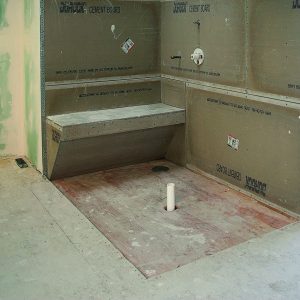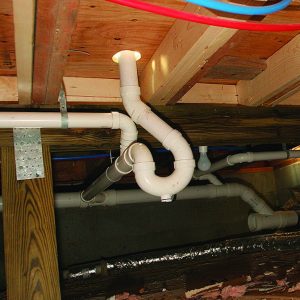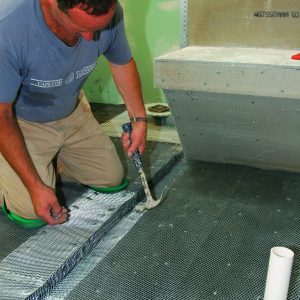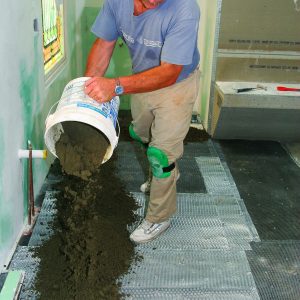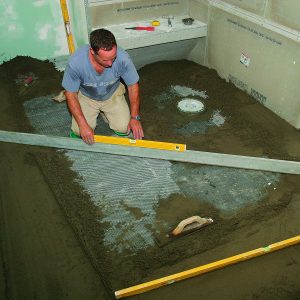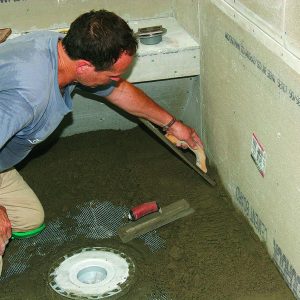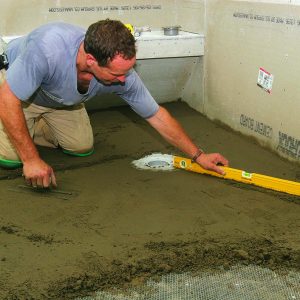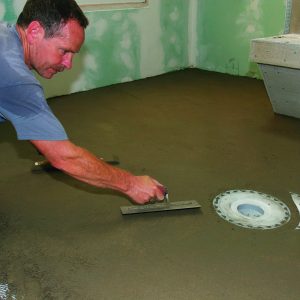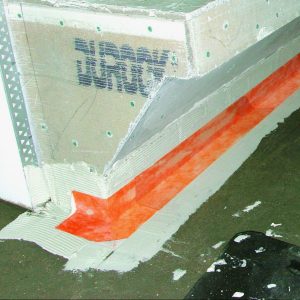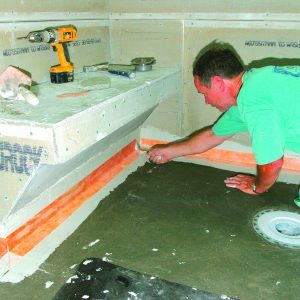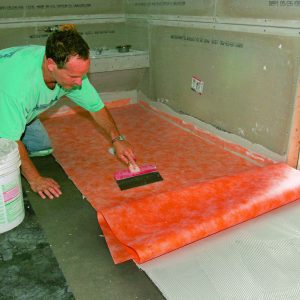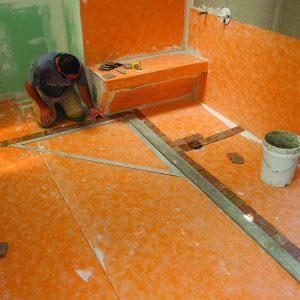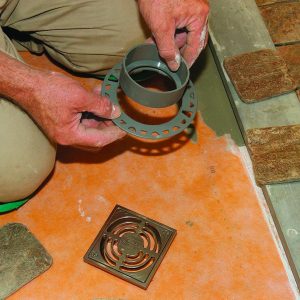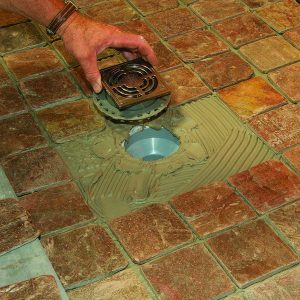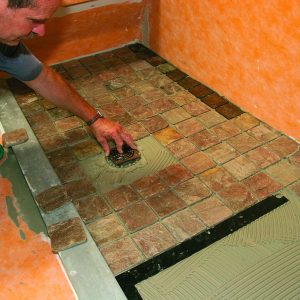A Sloping Floor for a Barrier-Free Bath
An old-fashioned mud job and a high-tech membrane team up for a leakproof floor.
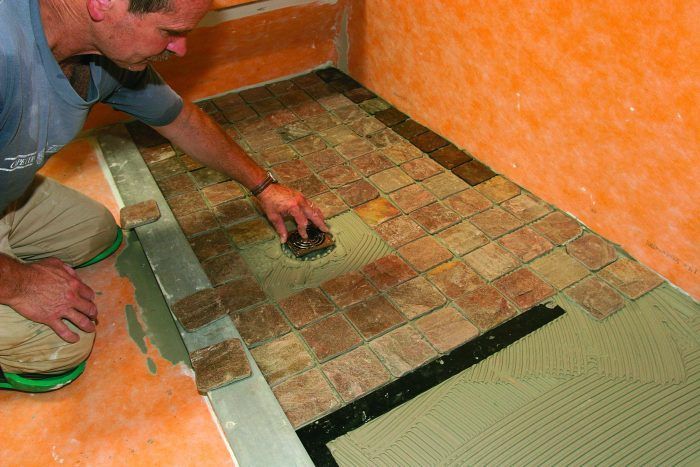
Synopsis: Long popular in Europe, bathrooms with curbless showers are more in demand with an aging population, who realize that someday they might need an ADA-compliant bath. Veteran tile installer Tom Meehan walks us through the most challenging aspect of Eurobath construction: the mortar substrate that must be gradually inclined toward the floor drain. An in-depth discussion of waterproof membrane installation and tile layout completes the six-page article.
One aspect of civilization that the Romans got right was the tiled bath. Since then, Europeans have built tiled bathrooms that present no distinction between the shower and the rest of the room. This design’s success depends on lots of tile and a mortar substrate that slopes to a strategically placed floor drain. A lack of thresholds also makes this kind of bathroom perfect for wheelchair access.
On this side of the pond, so called Eurobaths have found their way into the mainstream of American bathroom design, even when accessibility is not a factor. I recently completed such a bathroom for a homeowner who needed an accessible, elegant design.
Reframing the floor around the drain gets you ahead of the game
The key to a successful Eurobath is pitching the floor to a single drain in or near the shower area. The best way to create this pitched floor is with a full mortar bed, also called a mud job. The process is similar to what is done for a shower-stall floor, only now the mud job covers the entire room.
Before taking on a bathroom of this type, I check the existing floor for level. A floor pitched strongly away from the drain is usually enough for me to pass on the job. I also make sure the floor is good and strong without any bounce.
To keep the finished floor from ending too high at doorways, I had the carpenters on this job frame a 1½-in. recess in the shower area, replacing the 2×10 joists with narrower 2x6s that then were tripled for added strength. When reframing isn’t a viable option (on an upper floor or a slab, for instance), I get the drain as low as I can and use a smoother tile (2×2 or less) that won’t impede the flow toward the drain. I also have the option of using NobleFlex drain flashing. When the reframing was complete, I put a layer of #15 felt paper over the entire floor, then nailed down 2½-lb. diamond-mesh galvanized-wire lath with 1½-in. roofing nails, overlapping the mesh joints by at least an inch. Felt paper isolates the mortar bed from movement in the subfloor and keeps the wooden subfloor from sucking moisture out of the mortar as it dries. The wire lath anchors the mortar to the floor.
Get a head start on the slope
Screeds guide the floor pitch
In a large mortar box, I mix the mortar by thoroughly combining 25 shovelfuls of sand to each bag of portland cement; then I add water a little at a time (about 5 gal. per batch) until the mortar has a dry but stiff consistency. It should stay together when you form it into a ball in your hand. I plan for about 35 sq. ft. of coverage averaging a 1½-in. depth with each batch mixed as above.
I set the drain low enough to get a pitch of at least 1⁄4 in. per ft. After gluing the drain flange to the PVC waste line, I dump buckets of mortar around the perimeter of the room and around the drain in 8-in.- to 10-in.-high mounds. using a slightly wetter mortar mix, I make sure to fill the space under the flange completely.The height of the door thresh–old where the bathroom floor meets the adjacent floor is the most critical juncture. Taking into account the thickness of the floor tile and the height of the adjacent floor, I pack and flatten the mortar with a steel trowel until it is the proper height. With that as a standard height, I then work my way around the room’s perimeter. Because water is unlikely to reach the far corners of the room, I level the perimeter of the floor to allow the toilet, the vanity, and the tub to sit squarely.
Begin with mounds of mortar
The shower is a big shallow bowl
Now I’m ready to pitch the floor of the shower area. I dump a few buckets of mortar between the level perimeter and the drain, and pack the mortar into that area.
So that the mortar screeds evenly, one end of the straight–edge rides on the perimeter while the other end rides on the drain. As I work, I switch tools constantly, screeding with a level, packing with a steel trowel, and smoothing the surface with a wood float.
I find it easier to scrape the surface down to the finished height, so I keep the mortar slightly high, and use trowels and levels to pitch the floor to the drain. I continue to check the slant of the floor, pulling the excess mortar toward me to create a shallow bowl in the shower area.
Once the bowl is formed, the mortar is smoothed with a wood float to take out any small high begin with mounds of mortar(1) A dry mix of mortar is distributed evenly around the perimeter of the room. (2) After cementing the drain at the proper height, I fill the space below the flange with a slightly wetter mortar mix, making sure the space is filled completely. I then distribute more mortar around the shower area.12or low spots. Finally, I use a steel trowel at a shallow angle to press in a tight, shiny finish.
Pack, screed, smooth
My basic strategy here is to bed the drain, pack the mud flat and level around the higher perimeter of the floor, and then work at creating the slope between high and low.
A membrane waterproofs the mud
Because mortar is porous, it needs to be waterproofed with an impervious membrane. The membrane needs not only to cover the floor but also to extend at least 6 in. up the wall.
I used Schlüter’s Kerdi membrane for this project. Any nonlatex-modified thinset (also known as dry set) will attach the membrane to the mortar bed, but I used the recommended Ditra-Set (Bostik; www.bostik-us.com).
I begin by spreading thinset along the edges of the mor–tar bed and walls with a 3⁄16-in. V-notch trowel, then press the Kerdi preformed inside and out-side corners into place. using a taping knife with rounded corners, I squeeze out excess thin-set from beneath the corners, then coat the exposed surfaces to attach the overlapping layer.
Next, I cut a length from a 5-in.-wide roll of membrane and fold it in half down the middle. Pressed into the corners, the membrane should cover each side by 21⁄2 in. and overlap the previously installed corner pieces. As before, I flatten the membrane and squeeze out excess thinset.
Before installing the larger sections of membrane over the mortar bed, I sweep the floor thoroughly. Beginning in the shower area, I cut to length all sections and dry-fit them. The first section goes over the shower drain; I carefully mark and cut out the drain location, using a manufacturer’s template.
I also use a permanent marker to draw a line onto the mortar at the edge of the first section to guide the thinset application. Each successive section overlaps the line of the previous section about 3 in. After each section is dry-fit, I roll it up, number it, and put it aside.
When all the sections are cut, I spread thinset to the first guideline with a notched trowel. Spreading the thinset in one direction, I extend it onto the flange of the drain, then slowly unroll the first membrane section, keeping the edge aligned with the guideline. As membrane is unrolled, I press it into the thinset with a taping knife, keeping the membrane straight and flat by continually pushing excess thinset to the edge of the section. After bedding each section, I spread the thinset to the overlap line of the previous section before repeating the process. Finally, I apply a floor-to-ceiling membrane to the shower walls, using the same method that I 14used on the floors to ensure a waterproof installation.
A layered membrane seals the mortar
To waterproof the mortar bed completely, the membrane is applied in sequence.
Alternative membrane and drain flashing
Many manufacturers make waterproofing membranes, but over the past 25 years, I’ve used two brands with great success: Schlüter (www.schluter.com) and Noble (www.noblecompany.com). Although the membranes are slightly different, they both yield the same great results. Both manufacturers also offer reliable technical support.
For this project, I used Schlüter’s Kerdi membrane. The equivalent Noble product is NobleSeal TS. I usually opt for the Kerdi because it’s thinner (8 mil versus 31.5 mil for the NobleSeal TS) and therefore easier to work. Many installers choose NobleSeal TS, however, precisely because it’s thicker and heavier.
Both products are covered with a thin layer of fabric on each side that lets them adhere to thinset. However, Schlüter specifies that Kerdi be installed with nonlatex-modified thinset (dry set), while Noble requires a latex-modified thinset. One major advantage to NobleSeal TS is that it acts as a crack-isolation membrane in addition to waterproofing, making it an excellent choice over substrates like wood that are likely to move over time.
NobleSeal TS comes in 5-ft.-wide rolls, while Kerdi comes in 5-in., 71⁄4-in., 10-in., and 39-in. widths. Kerdi makes preformed inside and out-side corners; NobleSeal TS has just outside corners.
For the project featured here, I used Schlüter’s drain system, Kerdi-Drain. Noble makes an interesting product called NobleFlex Drain Flashing that can be used with most drains that have clamping rings. Resembling an upside-down hat, this flashing fits between 16-in. on-center joists, enabling me to gain a lot of floor pitch without reframing the floor.
Smaller tile means better drainage
After the membrane sits over–night, the floor is ready for tile. I protect the membrane with felt paper or cardboard to minimize any puncture risk. The only difference from a regular tile installation is that the membrane is now the substrate for the tile.
On this job, I installed 4-in.-sq. tumbled slate on the floor. Larger tile requires a little more pitch because the tiles can’t con–form to the shape of the floor as well as smaller tiles. I gave this floor a little more pitch than I tiling is the easy part (1) With a straightedge and a large folding square, I set the layout dry using a snapped chalkline to keep the irregular stone tile straight. (2, 3) After embed–ding a three-piece adjustable drain in thinset(4), I use a few taps of the trowel handle to set the finished flange to the level of the tile. the rest of the floor is tiled a few rows at a time. After the tile is installed, the stone is sealed, grouted, and sealed again to complete the floor.would for a typical handicapped-accessible bath because of the unevenness of the slate, which also can impede drainage.
I always start with a dry layout to see where the tile courses land. I try to use full tiles in areas that are seen first and most frequently. For this project, I first measured eight courses off the wall and snapped a chalkline across the room. Then I used a large folding square (C.h. hanson; www.asquaretools.com) to establish a line perpendicular to the first line. I dry-fit tiles along both lines and adjust the layout as needed. In this case, I was able to get the 4-in.-sq. drain to land perfectly within the tile layout.
With the layout set, I spread thinset and install tile the same as I would for any similar installation, working about 15 sq. ft. at a time. No matter what product is used, always follow the manufacturer’s recommendations. Again, I used Ditra-Set to set the tile. Because the uneven surface of the tile makes it harder to clean, I gave the tile two coats of sealer before grouting and another sealer coat afterward.
Tiling is the easy part
From Fine Homebuilding #185
For more photos, drawings, and details, click the View PDF button below:

